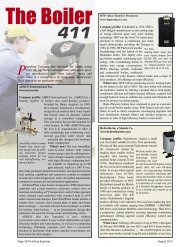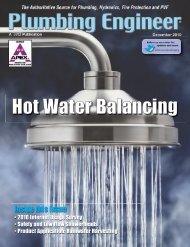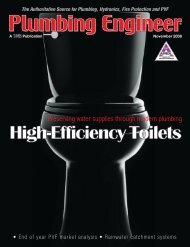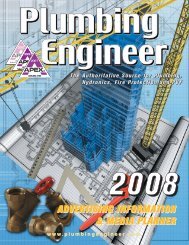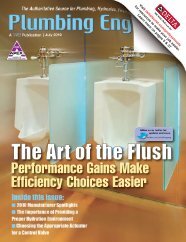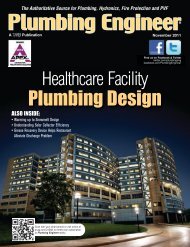open issue - Plumbing Engineer
open issue - Plumbing Engineer
open issue - Plumbing Engineer
Create successful ePaper yourself
Turn your PDF publications into a flip-book with our unique Google optimized e-Paper software.
Designer’s Guide<br />
Continued from page 26<br />
copper pipe because of the time it<br />
takes for the leaks to occur, combined<br />
with variations in water<br />
velocity and water chemistry. It is<br />
claimed that chloramines themselves<br />
do not cause corrosion,<br />
except in combination with aluminum,<br />
but sources such as Citizens<br />
Concerned About Chloramines<br />
sloan<br />
performance<br />
also comes in<br />
white<br />
Scan with<br />
Smart Phone<br />
for more<br />
information<br />
www.sloanvalve.com<br />
(CCAC) in San Francisco, as well as<br />
the EPA, make claims that chloramines<br />
will cause pinhole leaks<br />
purely by the nitrification they create,<br />
which lowers pH and causes<br />
pinhole leaks. Nitrification itself<br />
carries a host of other problems,<br />
such as loss of disinfectant residual<br />
and myriad health effects.<br />
<strong>Engineer</strong>ed and built exclusively for commercial use<br />
The perfect partner to our industry leading flushometers<br />
and faucets<br />
Maximum performance at any flush volume<br />
Smarter solutions from Sloan – the water efficiency experts<br />
Circle 18 on Reader Reply Form on page 69<br />
Another complicating factor in<br />
this debate is that many of the problematic<br />
leaks, at least here in So<br />
Cal, are the aforementioned slab<br />
leaks. While above-grade pinhole<br />
leaks can be sampled and studied,<br />
slab leaks are typically abandoned<br />
below grade and piping rerouted. As<br />
such, the leak source cannot be<br />
studied. A slab leak might be caused<br />
by a pinhole leak, or it might be<br />
caused by a cracked fitting or puncture<br />
from a rock due to building settlement.<br />
There is no practical way of<br />
knowing the cause.<br />
In my opinion, as well as that of<br />
the CCAC’s, water utilities should<br />
be banned from using chloramines<br />
until more accurate studies can be<br />
Water utilities should be<br />
banned from using<br />
chloramines until more<br />
accurate studies can be<br />
performed to determine a<br />
safe method for their use.<br />
performed to determine a safe<br />
method for their use. Until such<br />
time, a combination of filtration and<br />
traditional chlorine would better<br />
safeguard our health and copper<br />
piping. It would seem in the interest<br />
of the Copper Development<br />
Association (CDA) to lobby for this<br />
change. Perhaps they already are,<br />
but if this does not occur, the water<br />
utilities are pushing the industry<br />
toward increased use of plastics. I<br />
personally wish my home were<br />
piped in plastic rather than copper.<br />
If so, I wouldn’t have to turn my<br />
water off every time I leave the<br />
house for a day or more, due to lack<br />
of confidence in the copper piping.<br />
What angers me the most is attitudes<br />
such as that of Bob<br />
Gumerman, general manager of the<br />
MNWD, in response to the Shapell<br />
Industries’ $5 million claim. “If the<br />
water was to blame [for the pinhole<br />
leaks], the problem would be more<br />
widespread.” Well, Bob, get your<br />
head out of the sand, because the<br />
problem is so widespread that it is<br />
driving change in our industry and<br />
Page 28/<strong>Plumbing</strong> <strong>Engineer</strong> April 2012




